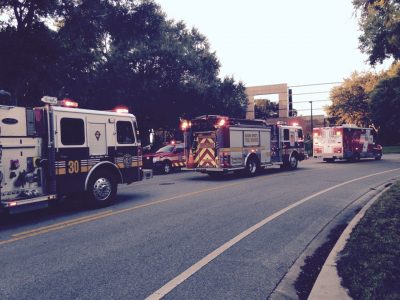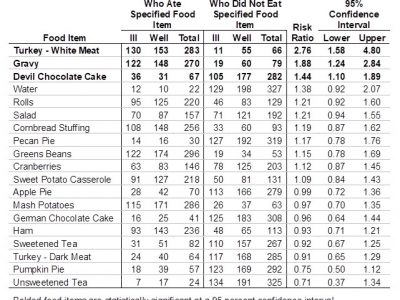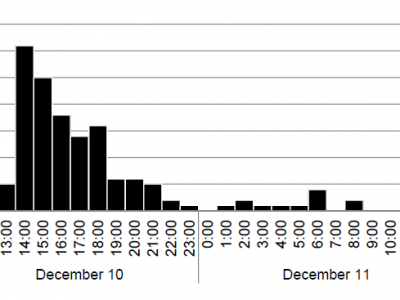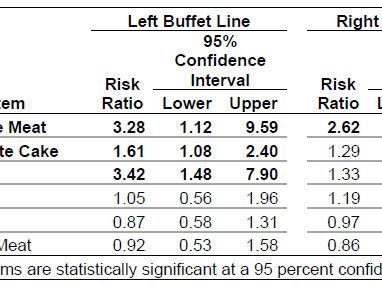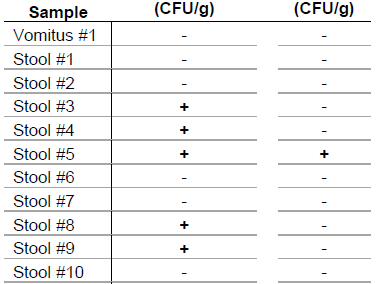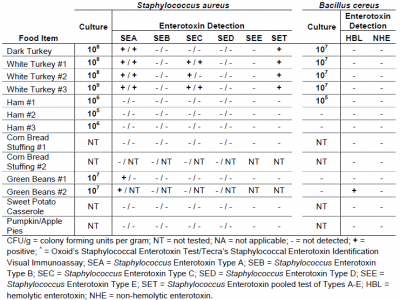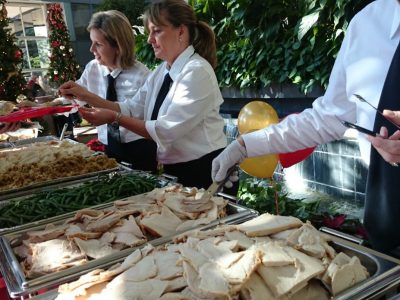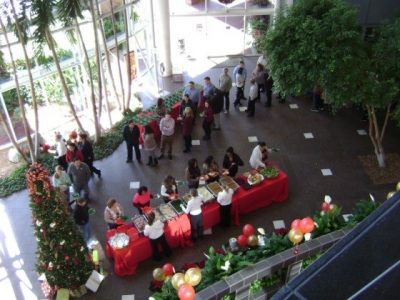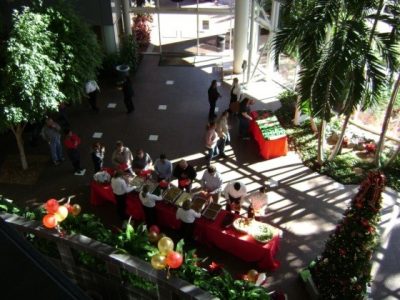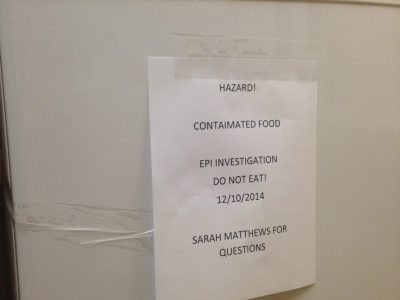| Outbreak: Holiday Lunch Buffet | |
|---|---|
| Product: Sliced Turkey Meat | Investigation Start Date: 12/10/2014 |
| Location: Maitland, Florida | Etiology: Staphylococcus aureus & Bacillus cereus |
| Earliest known case onset date: 12/10/2014 | Latest case onset date: 12/11/2014 |
| Confirmed/Presumptive Case Count: 6 / 135 | Positive Food Samples: 7 |
| Hospitalizations: 8 | Deaths: 0 |
An outbreak of gastrointestinal illness, which sickened 141 persons, was caused by sliced turkey contaminated with Staphylococcus aureus enterotoxins served during a catered holiday lunch buffet at a multi-business office complex in Maitland, Florida on December 10, 2014. The outbreak, initially reported to the Florida Department of Health in Orange County via the Mass Casualty Incident Notification System, had an immediate media exposure that covered on-camera ill persons being taken to the hospital via ambulance from the business complex.
The investigation identified that the food was prepared by the caterer at a commissary in Seminole County and then transported to and served at the office complex in Orange County. As a result, several local and state responding agencies with jurisdiction were required to closely coordinate rapid public health investigative and public communication efforts. Unsanitary food preparation practices and several cycles of thermal abuse at multiple locations where the catered food was handled were readily identified during the environmental health investigation.
Six clinical specimens and four different foods cultured Staphylococcus aureus. Staphylococcus aureus enterotoxin Type A and Type C were identified in food samples. In addition, Bacillus cereus was cultured from one clinical specimen and five food samples, and one food sample tested positive for the hemolytic enterotoxin.
At 3:47 PM on Wednesday, December 10, 2014, the Florida Department of Health in Orange County (DOH-Orange) was notified of an outbreak of possible food poisoning by a broadcast on the Mass Casualty Incident Notification System. Approximately 25 individuals, who were experiencing severe nausea, vomiting, and diarrhea, were reported to have been taken by ambulance to area hospitals following a catered holiday lunch buffet at a multi-business office complex in Maitland, Florida, which is in Orange County. At 5:00 PM, DOH-Orange interviewed via phone Caterer A, who reported making the holiday lunch buffet food for 700 people at Commissary A, located in Seminole County. The service of food was split into two buffet lines in the indoor lobby of the office complex from 11:30 AM to 1:00 PM. The leftover food was then stored in the refrigerator of a restaurant located within the office complex. A multi-jurisdictional outbreak investigation was immediately begun involving two local and two state agencies. In addition, public information messages were coordinated across agencies to provide information to the media which began coverage of the outbreak even before all ill persons could be evaluated and transported to the hospital (media coverage).
Passive surveillance during the investigation was conducted to identify potentially associated cases using the Florida Department of Health syndromic surveillance system, ESSENCE-FL, foodborne illness complaints, and reportable disease investigations. The investigation used active surveillance via outreach to Orlando-area hospital infection control practitioners to assist in identification of persons associated with the outbreak and specimen collection and testing. The outbreak confirmed case definition was an individual who became ill with diarrhea or vomiting within 24 hours following consumption of food from a catered holiday lunch buffet at the office complex from 11:30 AM to 1:00 PM on December 10, 2014 and was positive for the presence of toxigenic bacteria. A presumptive case definition was an individual who became ill with diarrhea or vomiting within 24 hours following consumption of food from a catered holiday lunch buffet at the office complex from 11:30 AM to 1:00 PM on December 10, 2014. A questionnaire was developed to assist the investigation in assessing multiple hypotheses into the source of the outbreak, including unintentional and intentional contamination of food served at the holiday lunch buffet, and potential common exposures unrelated to the holiday lunch buffet. The questionnaire was administered via telephone, in-person visits, and self-administration from December 12 through December 19. A retrospective cohort study design was used and data analyses were performed using the information collected from the questionnaires using EPI INFO 7 and SAS software.
The caterer and servers were interviewed multiple times to determine environmental risk factors and antecedents surrounding the source of food items, methods of storage, preparation, transportation, and food service. Multi-disciplinary team of epidemiologists and environmental health specialists from multiple local and state agencies were involved in the assessment process that encompassed a caterer, commissary, restaurant, private residence, and a building complex. Historical regulatory inspection records for the commissary and caterer were obtained. Eleven stool specimens, one vomitus specimen, and thirteen trays of leftover food were sent to the DOH Bureau of Public Health Laboratories (BPHL) and Centers for Disease Control and Prevention (CDC) for laboratory analysis, including culture and bacterial enterotoxin testing.
The caterer and servers were interviewed multiple times to determine environmental risk factors and antecedents surrounding the source of food items, methods of storage, preparation, transportation, and food service. Multi-disciplinary team of epidemiologists and environmental health specialists from multiple local and state agencies were involved in the assessment process that encompassed a caterer, commissary, restaurant, private residence, and a building complex. Historical regulatory inspection records for the commissary and caterer were obtained. Eleven stool specimens, one vomitus specimen, and thirteen trays of leftover food were sent to the DOH Bureau of Public Health Laboratories (BPHL) and Centers for Disease Control and Prevention (CDC) for laboratory analysis, including culture and bacterial enterotoxin testing. A total of 141 (40%) of 349 persons interviewed from 15 businesses reported symptoms matching the case definition. Frequently reported symptoms consisted of watery diarrhea (87%), abdominal cramps (77%), and nausea (77%). Among those ill, eight (6%) people were hospitalized. No deaths were reported. The first onset of illness among study participants was at 12:45 PM on December 10, 2014; the last onset of illness was at 12:00 PM on December 11, 2014 (Figure 1).
The incubation period ranged from 22 minutes to 23.5 hours with a median of 4.3 hours. The duration of illness ranged from 1-103 hours with a median of 22 hours. No commonalities beyond consumption of food at the holiday lunch buffet where identified that could explain the observed illnesses. The incubation period did not statistically differ and symptomology were similar between the different buffet lines. Attack rate by business did not provide further insight into the cause of the outbreak.Food items that had a statistically significant risk at the 95 percent confidence interval for becoming ill with gastrointestinal illness are as follows (from Table 1):
- •White turkey meat (RR (95%CI): 2.76 (1.58-4.80))
- •Gravy (RR (95%CI): 1.88 (1.24-2.84))
- •Devil chocolate cake (RR (95%CI): 1.44 (1.10-1.89)
With 36 (26 percent) study participants who became ill reporting consumption of the devil chocolate cake, this food item by itself was not determined to have caused the outbreak. Risk ratio calculations of implicated food items stratified by buffet line observed that only white turkey meat was statistically significant for being associated with illness in both buffet lines. Results (Table 2):
- •Left buffet line RR (95%CI): 3.28 (1.12-9.59)
- •Right buffet line RR (95%CI): 2.62 (1.37-4.99))
The dark turkey meat, white turkey meat, and ham cultured Staphylococcus aureus and Bacillus cereus (Table 3 and 4). Among these three food items, the white and dark turkey meat tested positive for the presence of Staphylococcus Enterotoxin Type A (SEA) and white turkey meat also tested positive for the presence of Staphylococcus Enterotoxin Type C (SEC). The presence of Bacillus cereus Enterotoxins were not detected in the dark turkey meat, white turkey meat, or ham. The green bean food samples submitted cultured Staphylococcus aureus but did not culture Bacillus cereus. SEA was detected in green bean samples as well as the Bacillus cereus hemolytic enterotoxin (HBL), but not the Bacillus cereus non-hemolytic enterotoxin (NHE). All other food items were negative.
All foods except the turkey and ham were prepared on December 10. The turkey and ham were prepared in stages from December 7-10. Temperatures were taken of initial cooked products, but temperature and time controls, monitoring during storage, preparation, cooking, hot holding and serving were non-existent. A total of 225 pounds of turkey and 146 pounds of ham were hand-sliced with utensils on surfaces that were un-sanitized prior to use. A scabbed sore and a cut on each person that sliced the meat were observed. Gloves were stated to be used during food preparation. Subsequent to the slicing process, the sliced ham was placed in 3-3.5 inch trays and turkey in 4-5 inch trays. Both were then covered with room temperature chicken broth and covered immediately in plastic wrap. Sliced meats were transported in insulated thermal units with ice packs and then stored in a commercial grade refrigeration unit at a private home. Ham slices were heated with sterno cans on December 10 to 120°F at the event location prior to serving. Turkey slices were reheated to an unknown temperature at the commissary on December 10 at 4:30 AM and transported to the event at 8:30 AM in the insulated thermal units heated to 159°F. The commissary had a history of vermin infestations and was used by six mobile units and fifteen caterers. Refrigeration unit accessible by the caterer at Commissary A was observed to not be capable of maintaining a temperature below 41°F.
This outbreak of gastrointestinal illness was caused by Staphylococcus aureus toxins in the turkey prepared and served by Caterer A at a holiday lunch buffet at a multi-business office complex in Maitland, Florida on December 10, 2014. The presence of Staphlococcus aureus toxin in the turkey, statistically significant association of illness with consumption of turkey, and the contamination of the turkey prior to thermal abuse during cooling and cold holding subsequent to the initial roasting process and prior to the end of the holiday lunch buffet strongly supports this conclusion. Contamination with Bacillus cereus of the turkey, ham and green beans served at the holiday lunch buffet contributed to the illnesses given the presence of either the pathogen or toxin in food samples and a clinical specimen. However, the degree to which illnesses were caused by each identified pathogen could not be determined. Cross-contamination of food items before, during, or following the holiday lunch buffet cannot be ruled out, which may have led to multiple food items acting as an outbreak causative vehicle or distortion of the true relationship. Initial food contamination during the holiday lunch buffet is not biologically plausible as there was insufficient time for the proliferation of the bacterial toxins prior to the end of food service. The presence of high concentrations of two types of pathogenic bacteria in several food products prepared at Commissary A by Caterer A personnel indicates a pattern of contamination and thermal abuse of the served food items.


